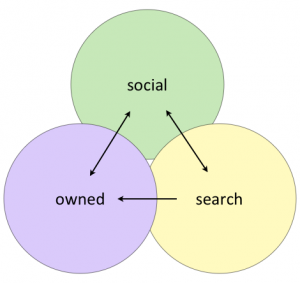It’s long been known that social media impacts a brand’s overall visibility, both through it’s reach into social media audiences as well as by generating new inbound links, wrapped in useful context, that search engines index and apply within their algorithm so as to (help) determine relevance.
The latter of these – the “boost” that social media gives to a brand’s visibility in organic search results, is a potentially useful source of outcomes based metrics for social media activities. Let me explain.
Google, according to a 2012 study, usually displays 10 results on it’s first page, 85% of which are organic with the remainder paid. Over half – 53% – of users will click on the first organic result. A further 34% will click on results 2-5. That’s a total of 87% of users clicking on the top five organic results. How much is a top five search result listing worth to a brand? A lot.
And it’s not just a brand or product name that needs to be found within search results – brands also want to be associated with key words related to their product or service offering so they can dangle those links in front of users with little or no brand awareness.
In instances where it’s possible to control for other factors, such as SEO activities, benchmarking a brand’s appearance in search results offers a useful opportunity to, during and after a social media campaign, measure progress towards a number of desired outcomes including:
- the ranking of brand owned pages in search results (from 3 and 5 to 1 and 2 for example)
- the dominance of the brand’s pages or pages containing references to it in results (from 20% of first page results to 40%, for example)
- the crowding out of the results of competitors, etc (three competitors appearing on front page instead of two)
In addition to measuring the (potential) impact of social media activities on search visibility, it is, of course, also possible to interrogate the brand or product website’s analytics to determine what impact, in terms of actual click-throughs, that enhanced search visibility has had. It might also be useful, when doing this, to conduct an analysis of how much a similar number of click-throughs would have cost through paid search placement activities. This allows direct comparison of costs vs benefits.
It’s not perfect, but search visibility and the resultant click-throughs are a reasonable enough place to start when beginning to measure progress towards specific outcomes, and starting to understand how the cost/benefits of social weigh up against those for paid search.
